Coevolution
In biology, coevolution occurs when two or more species reciprocally affect each other's evolution through the process of natural selection. The term sometimes is used for two traits in the same species affecting each other's evolution, as well as gene-culture coevolution.
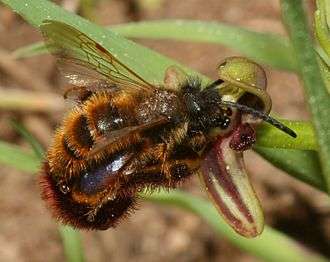
| Part of a series on |
| Evolutionary biology |
|---|
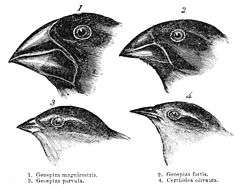 |
|
Key topics |
|
Fields and applications
|
|
Social implications
|
|
Charles Darwin mentioned evolutionary interactions between flowering plants and insects in On the Origin of Species (1859). Although he did not use the word coevolution, he suggested how plants and insects could evolve through reciprocal evolutionary changes. Naturalists in the late 1800s studied other examples of how interactions among species could result in reciprocal evolutionary change. Beginning in the 1940s, plant pathologists developed breeding programs that were examples of human-induced coevolution. Development of new crop plant varieties that were resistant to some diseases favored rapid evolution in pathogen populations to overcome those plant defenses. That, in turn, required the development of yet new resistant crop plant varieties, producing an ongoing cycle of reciprocal evolution in crop plants and diseases that continues to this day.
Coevolution as a major topic for study in nature expanded rapidly after the middle 1960s, when Daniel H. Janzen showed coevolution between acacias and ants (see below) and Paul R. Ehrlich and Peter H. Raven suggested how coevolution between plants and butterflies may have contributed to the diversification of species in both groups. The theoretical underpinnings of coevolution are now well-developed (e.g., the geographic mosaic theory of coevolution), and demonstrate that coevolution can play an important role in driving major evolutionary transitions such as the evolution of sexual reproduction or shifts in ploidy.[2][3] More recently, it has also been demonstrated that coevolution can influence the structure and function of ecological communities, the evolution of groups of mutualists such as plants and their pollinators, and the dynamics of infectious disease.[2][4]
Each party in a coevolutionary relationship exerts selective pressures on the other, thereby affecting each other's evolution. Coevolution includes many forms of mutualism, host-parasite, and predator-prey relationships between species, as well as competition within or between species. In many cases, the selective pressures drive an evolutionary arms race between the species involved. Pairwise or specific coevolution, between exactly two species, is not the only possibility; in multi-species coevolution, which is sometimes called guild or diffuse coevolution, several to many species may evolve a trait or a group of traits in reciprocity with a set of traits in another species, as has happened between the flowering plants and pollinating insects such as bees, flies, and beetles. There are a suite of specific hypotheses on the mechanisms by which groups of species coevolve with each other.[5]
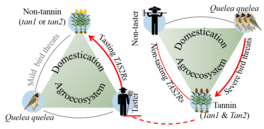
Domestication, a special mode of evolution, can offer a unique insight how multiple species evolve. Domestication is a process of human, based on own needs, select particular traits, which fit the local environments.[7] Condensed tannins can trigger bitter and unpleasant perceptions by binding to type 2 taste receptors (TAS2Rs). In East and South Africa, non-taster farmers (carrying ancestral TAS2R4 and TAS2R5) selected sorghum cultivars with high level of condensed tannins in seeds to deter Quelea quelea, while in West Africa with less pressure from Q. quelea, taster farmers (carrying derived TAS2R4 and TAS2R5) selected non-tannin sorghum for better food.[6]
Coevolution is primarily a biological concept, but researchers have applied it by analogy to fields such as computer science, sociology, and astronomy.
Mutualism
Coevolution is the evolution of two or more species which reciprocally affect each other, sometimes creating a mutualistic relationship between the species. Such relationships can be of many different types.[8][9]
Flowering plants
Flowers appeared and diversified relatively suddenly in the fossil record, creating what Charles Darwin described as the "abominable mystery" of how they had evolved so quickly; he considered whether coevolution could be the explanation.[10][11] He first mentioned coevolution as a possibility in On the Origin of Species, and developed the concept further in Fertilisation of Orchids (1862).[12][13][14]
Insects and entomophilous flowers
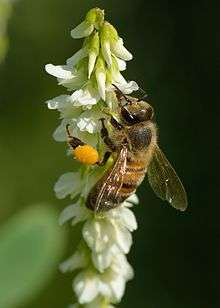
Modern insect-pollinated (entomophilous) flowers are conspicuously coadapted with insects to ensure pollination and in return to reward the pollinators with nectar and pollen. The two groups have coevolved for over 100 million years, creating a complex network of interactions. Either they evolved together, or at some later stages they came together, likely with pre-adaptations, and became mutually adapted.[15][16] Paul R. Ehrlich and Peter H. Raven in 1964 used a form of coevolution to describe the evolutionary interactions of plants and butterflies.[17]
Several highly successful insect groups—especially the Hymenoptera (wasps, bees and ants) and Lepidoptera (butterflies and moths) as well as many types of Diptera (flies) and Coleoptera (beetles)—evolved in conjunction with flowering plants during the Cretaceous (145 to 66 million years ago). The earliest bees, important pollinators today, appeared in the early Cretaceous.[18] A group of wasps sister to the bees evolved at the same time as flowering plants, as did the Lepidoptera.[18] Further, all the major clades of bees first appeared between the middle and late Cretaceous, simultaneously with the adaptive radiation of the eudicots (three quarters of all angiosperms), and at the time when the angiosperms became the world's dominant plants on land.[10]
At least three aspects of flowers appear to have coevolved between flowering plants and insects, because they involve communication between these organisms. Firstly, flowers communicate with their pollinators by scent; insects use this scent to determine how far away a flower is, to approach it, and to identify where to land and finally to feed. Secondly, flowers attract insects with patterns of stripes leading to the rewards of nectar and pollen, and colours such as blue and ultraviolet, to which their eyes are sensitive; in contrast, bird-pollinated flowers tend to be red or orange. Thirdly, flowers such as some orchids mimic females of particular insects, deceiving males into pseudocopulation.[18][1]
The yucca, Yucca whipplei, is pollinated exclusively by Tegeticula maculata, a yucca moth that depends on the yucca for survival.[19] The moth eats the seeds of the plant, while gathering pollen. The pollen has evolved to become very sticky, and remains on the mouth parts when the moth moves to the next flower. The yucca provides a place for the moth to lay its eggs, deep within the flower away from potential predators.[20]
Birds and ornithophilous flowers
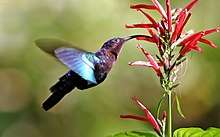
Hummingbirds and ornithophilous (bird-pollinated) flowers have evolved a mutualistic relationship. The flowers have nectar suited to the birds' diet, their color suits the birds' vision and their shape fits that of the birds' bills. The blooming times of the flowers have also been found to coincide with hummingbirds' breeding seasons. The floral characteristics of ornithophilous plants vary greatly among each other compared to closely related insect-pollinated species. These flowers also tend to be more ornate, complex, and showy than their insect pollinated counterparts. It is generally agreed that plants formed coevolutionary relationships with insects first, and ornithophilous species diverged at a later time. There is not much scientific support for instances of the reverse of this divergence: from ornithophily to insect pollination. The diversity in floral phenotype in ornithophilous species, and the relative consistency observed in bee-pollinated species can be attributed to the direction of the shift in pollinator preference.[21]
Flowers have converged to take advantage of similar birds.[22] Flowers compete for pollinators, and adaptations reduce unfavourable effects of this competition. The fact that birds can fly during inclement weather makes them more efficient pollinators where bees and other insects would be inactive. Ornithophily may have arisen for this reason in isolated environments with poor insect colonization or areas with plants which flower in the winter.[22][23] Bird-pollinated flowers usually have higher volumes of nectar and higher sugar production than those pollinated by insects.[24] This meets the birds' high energy requirements, the most important determinants of flower choice.[24] In Mimulus, an increase in red pigment in petals and flower nectar volume noticeably reduces the proportion of pollination by bees as opposed to hummingbirds; while greater flower surface area increases bee pollination. Therefore, red pigments in the flowers of Mimulus cardinalis may function primarily to discourage bee visitation.[25] In Penstemon, flower traits that discourage bee pollination may be more influential on the flowers' evolutionary change than 'pro-bird' adaptations, but adaptation 'towards' birds and 'away' from bees can happen simultaneously.[26] However, some flowers such as Heliconia angusta appear not to be as specifically ornithophilous as had been supposed: the species is occasionally (151 visits in 120 hours of observation) visited by Trigona stingless bees. These bees are largely pollen robbers in this case, but may also serve as pollinators.[27]
Following their respective breeding seasons, several species of hummingbirds occur at the same locations in North America, and several hummingbird flowers bloom simultaneously in these habitats. These flowers have converged to a common morphology and color because these are effective at attracting the birds. Different lengths and curvatures of the corolla tubes can affect the efficiency of extraction in hummingbird species in relation to differences in bill morphology. Tubular flowers force a bird to orient its bill in a particular way when probing the flower, especially when the bill and corolla are both curved. This allows the plant to place pollen on a certain part of the bird's body, permitting a variety of morphological co-adaptations.[24]

Ornithophilous flowers need to be conspicuous to birds.[24] Birds have their greatest spectral sensitivity and finest hue discrimination at the red end of the visual spectrum,[24] so red is particularly conspicuous to them. Hummingbirds may also be able to see ultraviolet "colors". The prevalence of ultraviolet patterns and nectar guides in nectar-poor entomophilous (insect-pollinated) flowers warns the bird to avoid these flowers.[24] Each of the two subfamilies of hummingbirds, the Phaethornithinae (hermits) and the Trochilinae, has evolved in conjunction with a particular set of flowers. Most Phaethornithinae species are associated with large monocotyledonous herbs, while the Trochilinae prefer dicotyledonous plant species.[24]
Fig reproduction and fig wasps
The genus Ficus is composed of 800 species of vines, shrubs, and trees, including the cultivated fig, defined by their syconiums, the fruit-like vessels that either hold female flowers or pollen on the inside. Each fig species has its own fig wasp which (in most cases) pollinates the fig, so a tight mutual dependence has evolved and persisted throughout the genus.[28]
Acacia ants and acacias
_with_Beltian_bodies%2C_Caves_Branch_Jungle_Lodge%2C_Belmopan%2C_Belize_-_8505045055.jpg)
The acacia ant (Pseudomyrmex ferruginea) is an obligate plant ant that protects at least five species of "Acacia" (Vachellia)[lower-alpha 1] from preying insects and from other plants competing for sunlight, and the tree provides nourishment and shelter for the ant and its larvae.[29][30] Such mutualism is not automatic: other ant species exploit trees without reciprocating, following different evolutionary strategies. These cheater ants impose important host costs via damage to tree reproductive organs, though their net effect on host fitness is not necessarily negative and, thus, becomes difficult to forecast.[31][32]
Hosts and parasites
Parasites and sexually reproducing hosts
Host–parasite coevolution is the coevolution of a host and a parasite.[33] A general characteristic of many viruses, as obligate parasites, is that they coevolved alongside their respective hosts. Correlated mutations between the two species enter them into an evolution arms race. Whichever organism, host or parasite, that cannot keep up with the other will be eliminated from their habitat, as the species with the higher average population fitness survives. This race is known as the Red Queen hypothesis.[34] The Red Queen hypothesis predicts that sexual reproduction allows a host to stay just ahead of its parasite, similar to the Red Queen's race in Through the Looking-Glass: "it takes all the running you can do, to keep in the same place".[35] The host reproduces sexually, producing some offspring with immunity over its parasite, which then evolves in response.[36]
The parasite–host relationship probably drove the prevalence of sexual reproduction over the more efficient asexual reproduction. It seems that when a parasite infects a host, sexual reproduction affords a better chance of developing resistance (through variation in the next generation), giving sexual reproduction variability for fitness not seen in the asexual reproduction, which produces another generation of the organism susceptible to infection by the same parasite.[37][38][39] Coevolution between host and parasite may accordingly be responsible for much of the genetic diversity seen in normal populations, including blood-plasma polymorphism, protein polymorphism, and histocompatibility systems.[40]
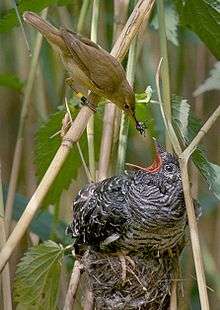
Brood parasites
Brood parasitism demonstrates close coevolution of host and parasite, for example in some cuckoos. These birds do not make their own nests, but lay their eggs in nests of other species, ejecting or killing the eggs and young of the host and thus having a strong negative impact on the host's reproductive fitness. Their eggs are camouflaged as eggs of their hosts, implying that hosts can distinguish their own eggs from those of intruders and are in an evolutionary arms race with the cuckoo between camouflage and recognition. Cuckoos are counter-adapted to host defences with features such as thickened eggshells, shorter incubation (so their young hatch first), and flat backs adapted to lift eggs out of the nest.[41][42][43]
Antagonistic coevolution
Antagonistic coevolution is seen in the harvester ant species Pogonomyrmex barbatus and Pogonomyrmex rugosus, in a relationship both parasitic and mutualistic. The queens are unable to produce worker ants by mating with their own species. Only by crossbreeding can they produce workers. The winged females act as parasites for the males of the other species as their sperm will only produce sterile hybrids. But because the colonies are fully dependent on these hybrids to survive, it is also mutualistic. While there is no genetic exchange between the species, they are unable to evolve in a direction where they become too genetically different as this would make crossbreeding impossible.[44]
Predators and prey
Predators and prey interact and coevolve: the predator to catch the prey more effectively, the prey to escape. The coevolution of the two mutually imposes selective pressures. These often lead to an evolutionary arms race between prey and predator, resulting in anti-predator adaptations.[45]
The same applies to herbivores, animals that eat plants, and the plants that they eat. In the Rocky Mountains, red squirrels and crossbills (seed-eating birds) compete for seeds of the lodgepole pine. The squirrels get at pine seeds by gnawing through the cone scales, whereas the crossbills get at the seeds by extracting them with their unusual crossed mandibles. In areas where there are squirrels, the lodgepole's cones are heavier, and have fewer seeds and thinner scales, making it more difficult for squirrels to get at the seeds. Conversely, where there are crossbills but no squirrels, the cones are lighter in construction, but have thicker scales, making it more difficult for crossbills to get at the seeds. The lodgepole's cones are in an evolutionary arms race with the two kinds of herbivore.[46]
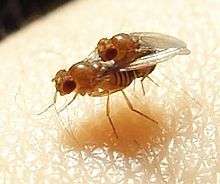
Competition
Both intraspecific competition, with features such as sexual conflict[47] and sexual selection,[48] and interspecific competition, such as between predators, may be able to drive coevolution.[49]
Multispecies coevolution (Guild or diffuse coevolution)
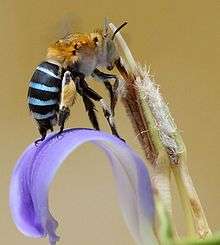
The types of coevolution listed so far have been described as if they operated pairwise (also called specific coevolution), in which traits of one species have evolved in direct response to traits of a second species, and vice versa. This is not always the case. Another evolutionary mode arises where evolution is still reciprocal, but is among a group of species rather than exactly two. This is called guild or diffuse coevolution. For instance, a trait in several species of flowering plant, such as offering its nectar at the end of a long tube, can coevolve with a trait in one or several species of pollinating insects, such as a long proboscis. More generally, flowering plants are pollinated by insects from different families including bees, flies, and beetles, all of which form a broad guild of pollinators which respond to the nectar or pollen produced by flowers.[50][51][52]
The geographic mosaic theory of coevolution
The geographic mosaic theory of coevolution was developed as a way of linking the ecological and evolutionary processes that shape interactions among species across ecosystems. It is based on three observations that are taken as assumptions: (1) species are usually groups of populations that are somewhat genetically distinct from each other, (2) interacting species often co-occur in only parts of their geographic ranges, and (3) interactions among species differ ecologically among environments.
From these assumptions, geographic mosaic theory suggests that natural selection on interactions among species is driven by three sources of variation:
1. Geographic selection mosaics occur in interactions among species, because genes are expressed in different ways in different environments and because different genes are favored in different environments. For example, natural selection on an interaction between a parasite population and a host population may differ between very dry environments and very wet environments. Alternatively, an interaction between two or more species may be antagonistic in some environments but mutualistic (beneficial to both or all species) in other environments.
2. Coevolutionary hotspots and coldspots occur because natural selection on interactions among species is reciprocal in some environments but not in others. For example, a symbiont population may decrease the survival or reproduction of its hosts in one environment, but it may have no effect on host survival or reproduction in another environment. When detrimental, natural selection will favor evolutionary responses in the host population, resulting in a coevolutionary hotspot of ongoing reciprocal evolutionary changes in the parasite and host populations. When the symbiont has no effect on the survival and reproduction of the host, natural selection on the symbiont population will not favor an evolutionary response by the host population (i.e, a coevolutionary coldspot).
3. Finally, there is constant remixing of the traits on which natural selection acts both locally and regionally. At any moment in time, a local population will have a unique combination of genes on which natural selection acts. These genetic differences among populations occur because each local population has a unique history of new mutations, genomic alterations (e.g., whole genome duplications), gene flow among populations from individuals arriving from other populations or going to other populations, random loss or fixation of genes at times when populations are small (random genetic drift), hybridization with other species, and other genetic and ecological processes that affect the raw genetic material on which natural selection acts. More formally, then, the geographic mosaic of coevolution can be viewed as a genotype by genotype by environment interaction (GxGxE) that results in the relentless evolution of interacting species.
Geographic mosaic theory has been explored through a wide range of mathematical models, studies of interacting species in nature, and laboratory experiments using microbial species and viruses.[5][3]
Outside biology
Coevolution is primarily a biological concept, but has been applied to other fields by analogy.
In algorithms
Coevolutionary algorithms are used for generating artificial life as well as for optimization, game learning and machine learning.[53][54][55][56][57] Daniel Hillis added "co-evolving parasites" to prevent an optimization procedure from becoming stuck at local maxima.[58] Karl Sims coevolved virtual creatures.[59]
In architecture
The concept of coevolution was introduced in architecture by the Danish architect-urbanist Henrik Valeur as an antithesis to the concept of "star-architecture".[60] As the curator of the Danish Pavilion at the 2006 Venice Biennale of Architecture he conceived and orchestrated the exhibition-project CO-EVOLUTION: Danish/Chinese Collaboration on Sustainable Urban Development in China, which was awarded the Golden Lion for Best National Pavilion.[61]
The exhibition included urban planning projects for the cities of Beijing, Chongqing, Shanghai, and Xi'an, which had been developed in collaboration between young professional Danish architects and architecture students and professors and students of architecture from the four Chinese cities.[62] By creating a framework for collaboration between academics and professionals representing two distinct cultures, it was hoped that the exchange of knowledge, ideas and experiences would stimulate "creativity and imagination to set the spark for new visions for sustainable urban development."[63] Valeur later argued that: "As we become more and more interconnected and interdependent, human development is no longer a matter of the evolution of individual groups of people but rather a matter of the co-evolution of all people."[64]
At the School of Architecture, Planning and Landscape, Newcastle University, a coevolutionary approach to architecture has been defined as a design practice that engages students, volunteers and members of the local community in practical, experimental work aimed at "establishing dynamic processes of learning between users and designers."[65]
In cosmology and astronomy
In his book The Self-organizing Universe, Erich Jantsch attributed the entire evolution of the cosmos to coevolution.
In astronomy, an emerging theory proposes that black holes and galaxies develop in an interdependent way analogous to biological coevolution.[66]
In management and organization studies
Since year 2000, a growing number of management and organization studies discuss coevolution and coevolutionary processes. Even so, Abatecola el al. (2020) reveals a prevailing scarcity in explaining what processes substantially characterize coevolution in these fields, meaning that specific analyses about where this perspective on socio-economic change is, and where it could move toward in the future, are still missing.[67]
In sociology
In Development Betrayed: The End of Progress and A Coevolutionary Revisioning of the Future (1994)[68] Richard Norgaard proposes a coevolutionary cosmology to explain how social and environmental systems influence and reshape each other.[69] In Coevolutionary Economics: The Economy, Society and the Environment (1994) John Gowdy suggests that: "The economy, society, and the environment are linked together in a coevolutionary relationship".[70]
In technology
Computer software and hardware can be considered as two separate components but tied intrinsically by coevolution. Similarly, operating systems and computer applications, web browsers, and web applications.
All of these systems depend upon each other and advance step by step through a kind of evolutionary process. Changes in hardware, an operating system or web browser may introduce new features that are then incorporated into the corresponding applications running alongside.[71] The idea is closely related to the concept of "joint optimization" in sociotechnical systems analysis and design, where a system is understood to consist of both a "technical system" encompassing the tools and hardware used for production and maintenance, and a "social system" of relationships and procedures through which the technology is tied into the goals of the system and all the other human and organizational relationships within and outside the system. Such systems work best when the technical and social systems are deliberately developed together.[72]
See also
Notes
- The acacia ant protects at least 5 species of "Acacia", now all renamed to Vachellia: V. chiapensis, V. collinsii, V. cornigera, V. hindsii, and V. sphaerocephala.
References
- van der Pijl, Leendert; Dodson, Calaway H. (1966). "Chapter 11: Mimicry and Deception". Orchid Flowers: Their Pollination and Evolution. Coral Gables: University of Miami Press. pp. 129–141. ISBN 978-0-87024-069-0.
- Nuismer, Scott (2017). Introduction to Coevolutionary Theory. New York: W.F. Freeman. p. 395. ISBN 978-1-319-10619-5. Archived from the original on 2019-05-02. Retrieved 2019-05-02.
- Thompson, John N. (2013-04-15). Relentless evolution. Chicago. ISBN 978-0-226-01861-4. OCLC 808684836.
- Guimarães, Paulo R.; Pires, Mathias M.; Jordano, Pedro; Bascompte, Jordi; Thompson, John N. (October 2017). "Indirect effects drive coevolution in mutualistic networks". Nature. 550 (7677): 511–514. Bibcode:2017Natur.550..511G. doi:10.1038/nature24273. ISSN 1476-4687. PMID 29045396.
- Thompson, John N. (2005). The geographic mosaic of coevolution. Chicago: University of Chicago Press. ISBN 978-0-226-11869-7. OCLC 646854337.
- Wu, Yuye; Guo, Tingting; Mu, Qi; Wang, Jinyu; Li, Xin; Wu, Yun; Tian, Bin; Wang, Ming Li; Bai, Guihua; Perumal, Ramasamy; Trick, Harold N. (December 2019). "Allelochemicals targeted to balance competing selections in African agroecosystems". Nature Plants. 5 (12): 1229–1236. doi:10.1038/s41477-019-0563-0. ISSN 2055-0278.
- Gepts, Paul (2010-06-24), "Crop Domestication as a Long-Term Selection Experiment", Plant Breeding Reviews, Oxford, UK: John Wiley & Sons, Inc., pp. 1–44, ISBN 978-0-470-65028-8, retrieved 2020-07-10
- Futuyma, D. J. and M. Slatkin (editors) (1983). Coevolution. Sinauer Associates. pp. whole book. ISBN 978-0-87893-228-3.CS1 maint: extra text: authors list (link)
- Thompson, J. N. (1994). The Coevolutionary Process. University of Chicago Press. pp. whole book. ISBN 978-0-226-79759-5.
- Cardinal, Sophie; Danforth, Bryan N. (2013). "Bees diversified in the age of eudicots". Proceedings of the Royal Society B. 280 (1755): 20122686. doi:10.1098/rspb.2012.2686. PMC 3574388. PMID 23363629.
- Friedman, W. E. (January 2009). "The meaning of Darwin's 'abominable mystery'". Am. J. Bot. 96 (1): 5–21. doi:10.3732/ajb.0800150. PMID 21628174.
- Thompson, John N. (1994). The coevolutionary process. Chicago: University of Chicago Press. ISBN 978-0-226-79760-1. Retrieved 2009-07-27.
- Darwin, Charles (1859). On the Origin of Species (1st ed.). London: John Murray. Retrieved 2009-02-07.
- Darwin, Charles (1877). On the various contrivances by which British and foreign orchids are fertilised by insects, and on the good effects of intercrossing (2nd ed.). London: John Murray. Retrieved 2009-07-27.
- Lunau, Klaus (2004). "Adaptive radiation and coevolution — pollination biology case studies". Organisms Diversity & Evolution. 4 (3): 207–224. doi:10.1016/j.ode.2004.02.002.
- Pollan, Michael (2003). The Botany of Desire: A Plant's-eye View of the World. Bloomsbury. ISBN 978-0-7475-6300-6.
- Ehrlich, Paul R.; Raven, Peter H. (1964). "Butterflies and Plants: A Study in Coevolution". Evolution. 18 (4): 586–608. doi:10.2307/2406212. JSTOR 2406212.
- "Coevolution of angiosperms and insects". University of Bristol Palaeobiology Research Group. Archived from the original on 20 December 2016. Retrieved 16 January 2017.
- Hemingway, Claire (2004). "Pollination Partnerships Fact Sheet" (PDF). Flora of North America: 1–2. Retrieved 2011-02-18.
Yucca and Yucca Moth
- Pellmyr, Olle; James Leebens-Mack (August 1999). "Forty million years of mutualism: Evidence for Eocene origin of the yucca-yucca moth association". Proc. Natl. Acad. Sci. USA. 96 (16): 9178–9183. Bibcode:1999PNAS...96.9178P. doi:10.1073/pnas.96.16.9178. PMC 17753. PMID 10430916.
- Kay, Kathleen M.; Reeves, Patrick A.; Olmstead, Richard G.; Schemske, Douglas W. (2005). "Rapid speciation and the evolution of hummingbird pollination in neotropical Costus subgenus Costus (Costaceae): evidence from nrDNA ITS and ETS sequences". American Journal of Botany. 92 (11): 1899–1910. doi:10.3732/ajb.92.11.1899. PMID 21646107. S2CID 2991957.
- Brown James H.; Kodric-Brown Astrid (1979). "Convergence, Competition, and Mimicry in a Temperate Community of Hummingbird-Pollinated Flowers". Ecology. 60 (5): 1022–1035. doi:10.2307/1936870. JSTOR 1936870. S2CID 53604204.
- Cronk, Quentin; Ojeda, Isidro (2008). "Bird-pollinated flowers in an evolutionary and molecular context". Journal of Experimental Botany. 59 (4): 715–727. doi:10.1093/jxb/ern009. PMID 18326865.
- Stiles, F. Gary (1981). "Geographical Aspects of Bird Flower Coevolution, with Particular Reference to Central America". Annals of the Missouri Botanical Garden. 68 (2): 323–351. doi:10.2307/2398801. JSTOR 2398801.
- Schemske, Douglas W.; Bradshaw, H.D. (1999). "Pollinator preference and the evolution of floral traits in monkeyflowers (Mimulus)". Proceedings of the National Academy of Sciences. 96 (21): 11910–11915. Bibcode:1999PNAS...9611910S. doi:10.1073/pnas.96.21.11910. PMC 18386. PMID 10518550.
- Castellanos, M. C.; Wilson, P.; Thomson, J.D. (2005). "'Anti-bee' and 'pro-bird' changes during the evolution of hummingbird pollination in Penstemon flowers". Journal of Evolutionary Biology. 17 (4): 876–885. doi:10.1111/j.1420-9101.2004.00729.x. PMID 15271088.
- Stein, Katharina; Hensen, Isabell (2011). "Potential Pollinators and Robbers: A Study of the Floral Visitors of Heliconia Angusta (Heliconiaceae) And Their Behaviour". Journal of Pollination Ecology. 4 (6): 39–47. doi:10.26786/1920-7603(2011)7.
- Suleman, Nazia; Sait, Steve; Compton, Stephen G. (2015). "Female figs as traps: Their impact on the dynamics of an experimental fig tree-pollinator-parasitoid community" (PDF). Acta Oecologica. 62: 1–9. Bibcode:2015AcO....62....1S. doi:10.1016/j.actao.2014.11.001.
- Hölldobler, Bert; Wilson, Edward O. (1990). The ants. Harvard University Press. pp. 532–533. ISBN 978-0-674-04075-5.
- National Geographic. "Acacia Ant Video". Archived from the original on 2007-11-07.
- Palmer TM, Doak DF, Stanton ML, Bronstein JL, Kiers ET, Young TP, Goheen JR, Pringle RM (2010). "Synergy of multiple partners, including freeloaders, increases host fitness in a multispecies mutualism". Proceedings of the National Academy of Sciences of the United States of America. 107 (40): 17234–9. Bibcode:2010PNAS..10717234P. doi:10.1073/pnas.1006872107. PMC 2951420. PMID 20855614.
- Mintzer, Alex; Vinson, S.B. (1985). "Kinship and incompatibility between colonies of the acacia ant Pseudomyrex ferruginea". Behavioral Ecology and Sociobiology. 17 (1): 75–78. doi:10.1007/bf00299432. JSTOR 4599807.
- Woolhouse, M. E. J.; Webster, J. P.; Domingo, E.; Charlesworth, B.; Levin, B. R. (December 2002). "Biological and biomedical implications of the coevolution of pathogens and their hosts" (PDF). Nature Genetics. 32 (4): 569–77. doi:10.1038/ng1202-569. hdl:1842/689. PMID 12457190.
- Van Valen, L. (1973). "A New Evolutionary Law". Evolutionary Theory. 1: 1–30. cited in: The Red Queen Principle
- Carroll, Lewis (1875) [1871]. Through the Looking-glass: And what Alice Found There. Macmillan. p. 42.
it takes all the running you can do, to keep in the same place.
- Rabajante, J.; et al. (2015). "Red Queen dynamics in multi-host and multi-parasite interaction system". Scientific Reports. 5: 10004. Bibcode:2015NatSR...510004R. doi:10.1038/srep10004. PMC 4405699. PMID 25899168.
- "Sexual reproduction works thanks to ever-evolving host, parasite relationships". PhysOrg. 7 July 2011.
- Morran, L.T.; Schmidt, O.G.; Gelarden, I.A.; Parrish, R.C. II; Lively, C.M. (8 July 2011). "Running with the Red Queen: Host-Parasite Coevolution Selects for Biparental Sex". Science. 333 (6039): 216–8. Bibcode:2011Sci...333..216M. doi:10.1126/science.1206360. PMC 3402160. PMID 21737739. Science.1206360.
- Hogan, C. Michael (2010). "Virus". In Cutler Cleveland; Sidney Draggan (ed.). Encyclopedia of Earth.
- Anderson, R.; May, R. (October 1982). "Coevolution of hosts and parasites". Parasitology. 85 (2): 411–426. doi:10.1017/S0031182000055360. PMID 6755367.
- Weiblen, George D. (May 2003). "Interspecific Coevolution" (PDF). Macmillan.
- Rothstein, S.I (1990). "A model system for coevolution: avian brood parasitism". Annual Review of Ecology and Systematics. 21: 481–508. doi:10.1146/annurev.ecolsys.21.1.481.
- Davies, N. B. (Nicholas B.), 1952-. Cuckoo : cheating by nature. McCallum, James (Wildlife artist) (First U.S. ed.). New York, NY. ISBN 978-1-62040-952-7. OCLC 881092849.CS1 maint: multiple names: authors list (link)
- Herrmann, M.; Cahan, S. H. (29 October 2014). "Inter-genomic sexual conflict drives antagonistic coevolution in harvester ants". Proceedings of the Royal Society B: Biological Sciences. 281 (1797): 20141771. doi:10.1098/rspb.2014.1771. PMC 4240986. PMID 25355474.
- "Predator-Prey Relationships". New England Complex Systems Institute. Retrieved 17 January 2017.
- "Coevolution". University of California Berkeley. Retrieved 17 January 2017. and the two following pages of the web article.
- Parker, G. A. (2006). "Sexual conflict over mating and fertilization: An overview". Philosophical Transactions of the Royal Society B: Biological Sciences. 361 (1466): 235–59. doi:10.1098/rstb.2005.1785. PMC 1569603. PMID 16612884.
- "Biol 2007 - Coevolution". University College, London. Retrieved 19 January 2017.
- Connell, Joseph H. (October 1980). "Diversity and the Coevolution of Competitors, or the Ghost of Competition Past". Oikos. 35 (2): 131–138. doi:10.2307/3544421. JSTOR 3544421. S2CID 5576868.
- Juenger, Thomas, and Joy Bergelson. "Pairwise versus diffuse natural selection and the multiple herbivores of scarlet gilia, Ipomopsis aggregata." Evolution (1998): 1583–1592.
- Gullan, P. J.; Cranston, P. S. (2010). The Insects: An Outline of Entomology (4th ed.). Wiley. pp. 291–293. ISBN 978-1-118-84615-5.
- Rader, Romina; Bartomeus, Ignasi; et al. (2016). "Non-bee insects are important contributors to global crop pollination". PNAS. 113 (1): 146–151. Bibcode:2016PNAS..113..146R. doi:10.1073/pnas.1517092112. PMC 4711867. PMID 26621730.
- Potter M. and K. De Jong, Evolving Complex Structures via Cooperative Coevolution, Fourth Annual Conference on Evolutionary Programming, San Diego, CA, 1995.
- Potter M., The Design and Computational Model of Cooperative Coevolution, PhD thesis, George Mason University, Fairfax, Virginia, 1997.
- Potter, Mitchell A.; De Jong, Kenneth A. (2000). "Cooperative Coevolution: An Architecture for Evolving Coadapted Subcomponents". Evolutionary Computation. 8 (1): 1–29. CiteSeerX 10.1.1.134.2926. doi:10.1162/106365600568086. PMID 10753229.
- Weigand P., Liles W., De Jong K., An empirical analysis of collaboration methods in cooperative coevolutionary algorithms. Proceedings of the Genetic and Evolutionary Computation Conference (GECCO) 2001.
- Weigand P., An Analysis of Cooperative Coevolutionary Algorithms, PhD thesis, George Mason University, Fairfax, Virginia, 2003.
- Hillis, W.D. (1990), "Co-evolving parasites improve simulated evolution as an optimization procedure", Physica D: Nonlinear Phenomena, 42 (1–3): 228–234, Bibcode:1990PhyD...42..228H, doi:10.1016/0167-2789(90)90076-2
- Sims, Karl (1994). "Evolved Virtual Creatures". Karl Sims. Retrieved 17 January 2017.
- "Henrik Valeur's biography". Retrieved 2015-08-29.
- "About CO-EVOLUTION". Danish Architecture Centre. Archived from the original on 2015-11-20. Retrieved 2015-08-29.
- "An interview with Henrik Valeur". Movingcities. 2007-12-17. Retrieved 2015-10-17.
- Valeur, Henrik (2006). CO-EVOLUTION: Danish/Chinese Collaboration on Sustainable Urban Development in China. Copenhagen: Danish Architecture Centre. p. 12. ISBN 978-87-90668-61-7.
- Valeur, Henrik (2014). India: the Urban Transition - a Case Study of Development Urbanism. Architectural Publisher B. p. 22. ISBN 978-87-92700-09-4.
- Farmer, Graham (2017). "From Differentiation to Concretisation: Integrative Experiments in Sustainable Architecture". Societies. 3 (35): 18. doi:10.3390/soc7040035.
- Gnedin, Oleg Y.; et al. (2014). "Co-Evolution of Galactic Nuclei and Globular Cluster Systems". The Astrophysical Journal. 785 (1): 71. arXiv:1308.0021. Bibcode:2014ApJ...785...71G. doi:10.1088/0004-637X/785/1/71.
- Abatecola, Gianpaolo; Breslin, Dermot; Kask, Johan (2020). "Do organizations really co-evolve? Problematizing co-evolutionary change in management and organization studies". Technological Forecasting and Social Change. 155: 119964. doi:10.1016/j.techfore.2020.119964. ISSN 0040-1625.
- Norgaard, Richard B. (1994). Development Betrayed: The End of Progress and a Coevolutionary Revisioning of the Future. Routledge.
- Glasser, Harold (1996). "Development Betrayed: The End of Progress and A Coevolutionary Revisioning of the Future by Richard B. Norgaard". Environmental Values. 5 (3): 267–270. JSTOR 30301478.
- Gowdy, John (1994). Coevolutionary Economics: The Economy, Society and the Environment. Springer. pp. 1–2.
- Theo D'Hondt, Kris De Volder, Kim Mens and Roel Wuyts, Co-Evolution of Object-Oriented Software Design and Implementation, TheKluwer International Series in Engineering and Computer Science, 2002, Volume 648, Part 2, 207–224 doi:10.1007/978-1-4615-0883-0_7
- Cherns, A. (1976). "The principles of sociotechnical design". Human Relations. 29 (8): 8. doi:10.1177/001872677602900806.
External links
- Coevolution, video of lecture by Stephen C. Stearns (Open Yale Courses)
